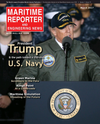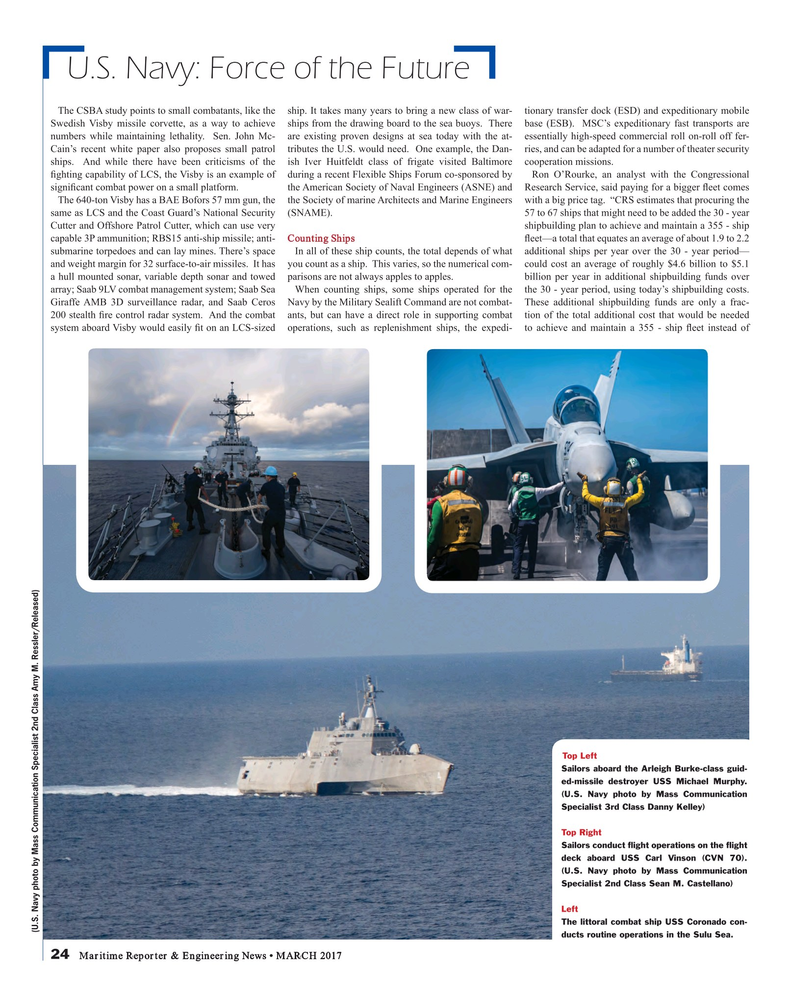
Page 24: of Maritime Reporter Magazine (March 2017)
U.S. Navy Quarterly & Maritime Simulation Technologies
Read this page in Pdf, Flash or Html5 edition of March 2017 Maritime Reporter Magazine
U.S. Navy: Force of the Future
The CSBA study points to small combatants, like the ship. It takes many years to bring a new class of war- tionary transfer dock (ESD) and expeditionary mobile
Swedish Visby missile corvette, as a way to achieve ships from the drawing board to the sea buoys. There base (ESB). MSC’s expeditionary fast transports are numbers while maintaining lethality. Sen. John Mc- are existing proven designs at sea today with the at- essentially high-speed commercial roll on-roll off fer-
Cain’s recent white paper also proposes small patrol tributes the U.S. would need. One example, the Dan- ries, and can be adapted for a number of theater security ships. And while there have been criticisms of the ish Iver Huitfeldt class of frigate visited Baltimore cooperation missions.
? ghting capability of LCS, the Visby is an example of during a recent Flexible Ships Forum co-sponsored by Ron O’Rourke, an analyst with the Congressional signi? cant combat power on a small platform. the American Society of Naval Engineers (ASNE) and Research Service, said paying for a bigger ? eet comes
The 640-ton Visby has a BAE Bofors 57 mm gun, the the Society of marine Architects and Marine Engineers with a big price tag. “CRS estimates that procuring the same as LCS and the Coast Guard’s National Security (SNAME). 57 to 67 ships that might need to be added the 30 - year
Cutter and Offshore Patrol Cutter, which can use very shipbuilding plan to achieve and maintain a 355 - ship capable 3P ammunition; RBS15 anti-ship missile; anti- Counting Ships ? eet—a total that equates an average of about 1.9 to 2.2 submarine torpedoes and can lay mines. There’s space In all of these ship counts, the total depends of what additional ships per year over the 30 - year period— and weight margin for 32 surface-to-air missiles. It has you count as a ship. This varies, so the numerical com- could cost an average of roughly $4.6 billion to $5.1 a hull mounted sonar, variable depth sonar and towed parisons are not always apples to apples. billion per year in additional shipbuilding funds over array; Saab 9LV combat management system; Saab Sea When counting ships, some ships operated for the the 30 - year period, using today’s shipbuilding costs.
Giraffe AMB 3D surveillance radar, and Saab Ceros Navy by the Military Sealift Command are not combat- These additional shipbuilding funds are only a frac- 200 stealth ? re control radar system. And the combat ants, but can have a direct role in supporting combat tion of the total additional cost that would be needed system aboard Visby would easily ? t on an LCS-sized operations, such as replenishment ships, the expedi- to achieve and maintain a 355 - ship ? eet instead of
Top Left
Sailors aboard the Arleigh Burke-class guid- ed-missile destroyer USS Michael Murphy. (U.S. Navy photo by Mass Communication
Specialist 3rd Class Danny Kelley)
Top Right
Sailors conduct ? ight operations on the ? ight deck aboard USS Carl Vinson (CVN 70). (U.S. Navy photo by Mass Communication
Specialist 2nd Class Sean M. Castellano)
Left
The littoral combat ship USS Coronado con- (U.S. Navy photo by Mass Communication Specialist 2nd Class Amy M. Ressler/Released) ducts routine operations in the Sulu Sea. 24 Maritime Reporter & Engineering News • MARCH 2017
MR #3 (18-25).indd 24 MR #3 (18-25).indd 24 3/6/2017 10:41:10 AM3/6/2017 10:41:10 AM

 23
23

 25
25
